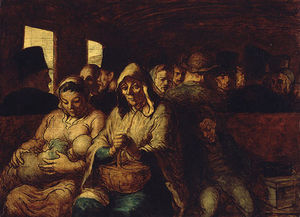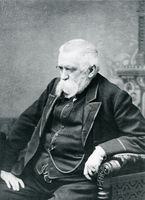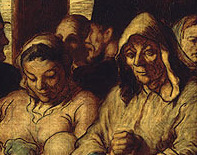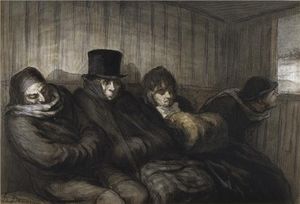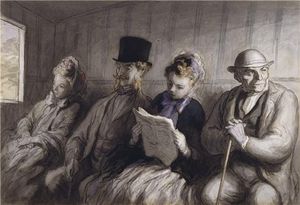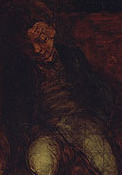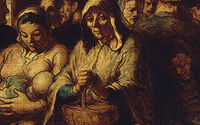The Third-Class Carriage
- Date of Creation:
- 1864
- Alternative Names:
- Le Wagon de troisième classe
- Height (cm):
- 65.40
- Length (cm):
- 90.20
- Medium:
- Oil
- Support:
- Canvas
- Subject:
- Scenery
- Art Movement:
- Realism
- Created by:
- Current Location:
- New York, New York
- Displayed at:
- Metropolitan Museum of Art
- Owner:
- Metropolitan Museum of Art
- The Third-Class Carriage Page's Content
- Story / Theme
- Inspirations for the Work
- Analysis
- Critical Reception
- Related Paintings
- Artist
- Art Period
- Bibliography
The Third-Class Carriage Story / Theme
The story of The Third-Class Carriage, otherwise known as Le Wagon de troisième classe, is that of a family. Three generations are present here: young, middle-aged and old, almost as if it were the full spectrum of human life. Grown men are most notably absent, suggesting that these women are making their way in the world on their own. Although the mother's face is sweet, the weariness present in the grandmother's face suggests the hardships that she must have experienced in her long life. Her shrewd face confronts the viewer.
It was William Thomas Walters who commissioned Daumier to paint The Third-Class Carriage. It is one part of a three-part series which also includes The First Class Carriage and The Second Class Carriage. Daumier was primarily a lithographer because he could not make a commercial success of himself as a painter and The Third-Class Carriage is one of his few recorded painting commissions.
William Thomas Walters had a passion for art and once he was able to afford a nice house in a fashionable part of town, he began to collect works from local artists. Walters grew up with the increasing turmoil that preceded the Civil War in the United States. Although a Northerner, he vehemently defended the right of the Southern states to secede from the union. When the conflict finally erupted in 1861, Walters was left in an unenviable position and decided to leave the country for Paris with his family.
In a city such as Paris, Walters continued to collect art although his income was more limited than it had been before the Civil War. Walters principally collected from three artists: Jean-Leon Gerome, Antoine-Louis Barye and, of course, Honore Daumier.
Upon his return to the United States in 1865 at the end of the Civil War, Walters disinvested from liquor and placed his money in banking and railroads. Undoubtedly, this is why Walters took enough of an interest in the life of his would-be passengers to commission this painting.
The Third-Class Carriage Inspirations for the Work
Le Wagon de Troisieme Classe or The Third-Class Carriage as it is known in English, is actually one of a three-part series commissioned by Walter Thompson Walters, the other two works being The First Class Carriage and The Second Class Carriage. The inspiration for this painting came from the railroad itself.
More than just a machine, the railroad wreaked many changes on every society it touched. Before the invention of the railroad, people were forced to rely either on their own two feet, an animal or the whims of nature (such as wind for a sailboat. ) The railroad interrupted this simple life by charging through areas that had formerly been wilderness, leaving a cloud of noxious smoke in its wake as it connected people to places at a rate never thought possible.
The invention and widespread use of the railroad was but one of the many changes heralded by the Industrial Revolution. The Industrial Revolution refers to the period from the late 1800s and early 1900s where major changes took place in agriculture, manufacturing and transportation. The Industrial Revolution began in the United Kingdom but soon spread to Europe, North America and eventually the rest of the world. The Industrial Revolution had a profound effect on the socioeconomic and cultural conditions of mankind. Almost every aspect of daily life came to eventually be influenced by the Industrial Revolution in some way.
Before the Industrial Revolution, most of mankind lived in feudal societies: there were the upper-class, the peasants and a small middle-class composed of merchants. The Industrial Revolution did not alter this class dynamic, but it did change how people fulfilled their roles. The people in Daumier's The Third-Class Carriage, are probably former peasants who are traveling to the city in search of jobs. The mechanization of agriculture that the Industrial Revolution caused is probably responsible for this. The man who formerly hired the people in the third-class carriage to work his lands probably no longer needed them because he had a machine to do the work for him.
However, the mechanical changes wrought by the Industrial Revolution have also allowed some people to open factories to, among other things, mass-produce goods. As is the case with the peasants, this will put the artesian out of a job. But the peasants and artesian will still have these factory jobs to go to. The Industrial Revolution, although bad for some, did allow many people to enter the middle class. Mass-production of goods expanded the ranks of the middle-class, primarily in the form of the merchant class.
The Third-Class Carriage Analysis
Like with many of Daumier's later paintings, the loose handling and calligraphic brush work that he employs in The Third-Class Carriage is extraordinary. Since the painting is left unfinished, it is impossible to analyze it fully as we will never know the artists true intent. However, it is still obvious that Daumier seeks to capture the plight of the working class by capturing the quiet moments of their everyday lives. One gets a sense of their circumstances through the weariness of their posture and the shabbiness of their clothes.
Composition:
The background takes up more space than the foreground and is unusually detailed for Daumier. The third-class family faces away from the rest of the passengers, which emphasizes its isolation and rejection from the rest of society.
Use of space:
The family figures are drawn in larger proportion than their distance from the rest of the passengers would warrant, which gives them a more commanding presence. The upper-third of the painting is left blank, which suggests a space that is cavernous when it comes to height, but very cramped when it comes to length.
Use of color:
This painting is unfinished, so Daumier's true intent cannot be known.
Use of lighting:
The lighting provides a nice and unexpected contrast to the somber tones. Because the painting is unfinished we have no way of knowing if it would have maintained its sunny character.
Mood:
The mood of the painting is one of transit itself. One is on the move but also resigned and waiting for something to happen, for example, they might be en route to a new job or to a friend's house.
Brushstroke:
As much as possible, Daumier uses economy of line to keep his drawings simple and powerful which is evident in the hands of the mother, for example.
The Third-Class Carriage Critical Reception
The critical reception to Honore Daumier's paintings, such as Third-class Carriage, was not very promising. In most cases, his efforts were ignored until after his death. Daumier desired to be a painter but had to produce lithographs constantly at a pittance to support himself.
The Third-Class Carriage is one of his few commissioned paintings. The other two paintings in the series, The First Class Carriage and The Second Class Carriage did not receive nearly as much notice and are widely known only by art scholars. The Third-Class Carriage is seen to be an accurate depiction of working-class life in mid-eighteenth century France and is remembered for this accordingly.
The Third-Class Carriage Related Paintings
The Third-Class Carriage Artist
The Third-Class Carriage came about when Daumier decided to switch from politics to society, presumably for his own sake. Although he mainly criticized the bourgeoisie, in The Third-Class Carriage, Daumier adopts a more genteel tone when depicting the everyday lives of the working-class.
The Third-Class Carriage demonstrates Daumier's famous sympathy for the poor. This painting is both a family story and one of mankind. All stages of the life cycle are present among the passengers: baby, child, mother and grandmother. It is in quiet moments, such as riding in a shabby train car, that the weariness of the lives of the poor is captured.
The family depicted in The Third-class Carriage folds in on itself, isolated and absorbed in thought. The grandmother looks especially worn-out, as the central figure her eyes tell the tale of all the suffering she must have experienced in her long life. Her shrewd face confronts the viewer but the mother with her child and the boy look innocent. For an artist who routinely made bitter characterizations of high officials, this is a surprisingly sensitive depiction of the everyday life of the poor.
Daumier was a talented artist whose works ranged across many mediums and emotional depths. Although famous for his lithographs, Daumier desired to be a painter. But his works were so avant-garde that he found little commercial following and was forced to churn out lithograph after lithograph in order to support himself. Daumier was an extremely prolific artist who produced almost 4,000 cartoons and he created many of his paintings in his later years. As with his lithographs, his paintings, such as The Third-Class Carriage, were marked by searing directness as he focused on religious, historical and social justice issues.
Daumier was also a talented sculptor, but this was a much maligned art during that period. He sculpted clay figures to work from while he produced his lithographs and paintings. Unfortunately, as soon as Daumier finished the paintings, he destroyed the clay figurines so most of them are lost to posterity.
The Third-Class Carriage Art Period
The French Realist movement took place from 1848, during the aftermath of the French revolution, until the late 1800s when the Second Empire under Napoleon 3rd was in swing. French Realism sprung up at the same time as modern-day journalism and in similar ways the French Realist movement sought to convey an honest and objective vision of contemporary life. French artists democratized art by depicting the everyday lives of the working class while radicals and socialists fought for revolutionary reform.
The Third-class Carriage helps the revolutionary cause by portraying a family as humbly dressed. The weariness and suffering of the working-class is captured in the gaze of the grandmother, who at the end of her long life, confronts the viewer. Daumier painted two others in this series: The First Class Carriage and The Second Class Carriage but these are not as well-known, considering the focus of Realism during this time.
The Third-Class Carriage Bibliography
You can find out more about Daumier and his fascinating works by referring to the recommended reading list and web sources listed here.
Books:
• Daumier, Honore. The Drawings of Daumier (1978)
• Laughton, Bruce. Honore Daumier (1996)
• Longstreet, Stephen. The Drawings of Daumier (1964)
• Symmons, Sarah. Daumier (2005)
Web Sources:
• http://www.daumier.org/1.0.html
• http://www.encyclopedia.com/topic/Honore_Daumier.aspx

